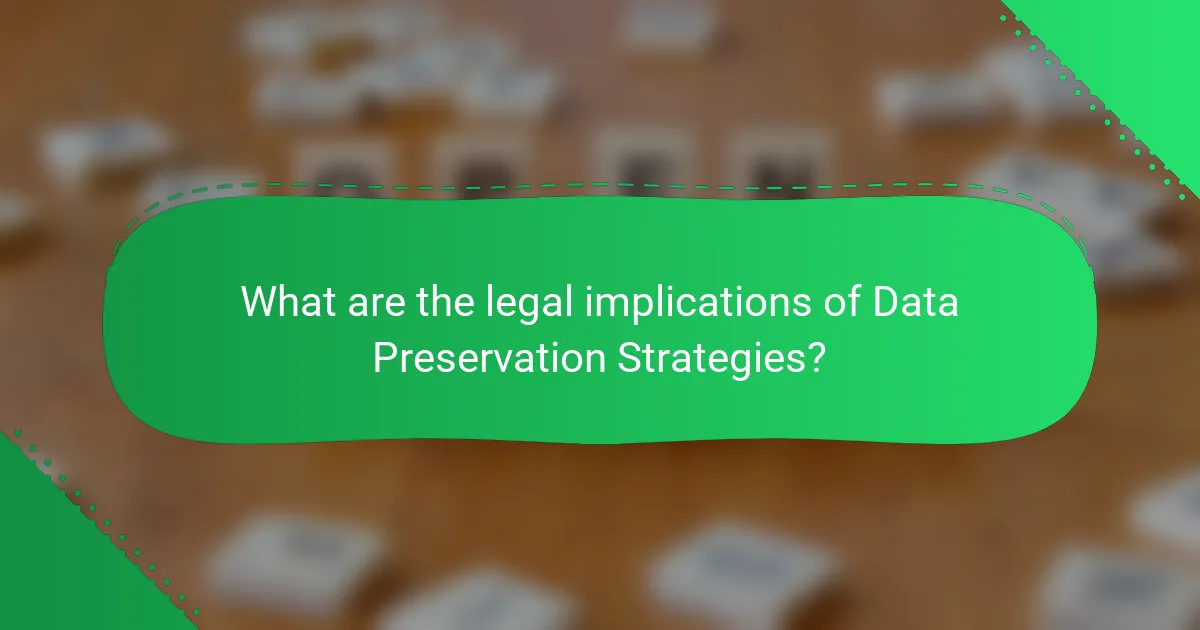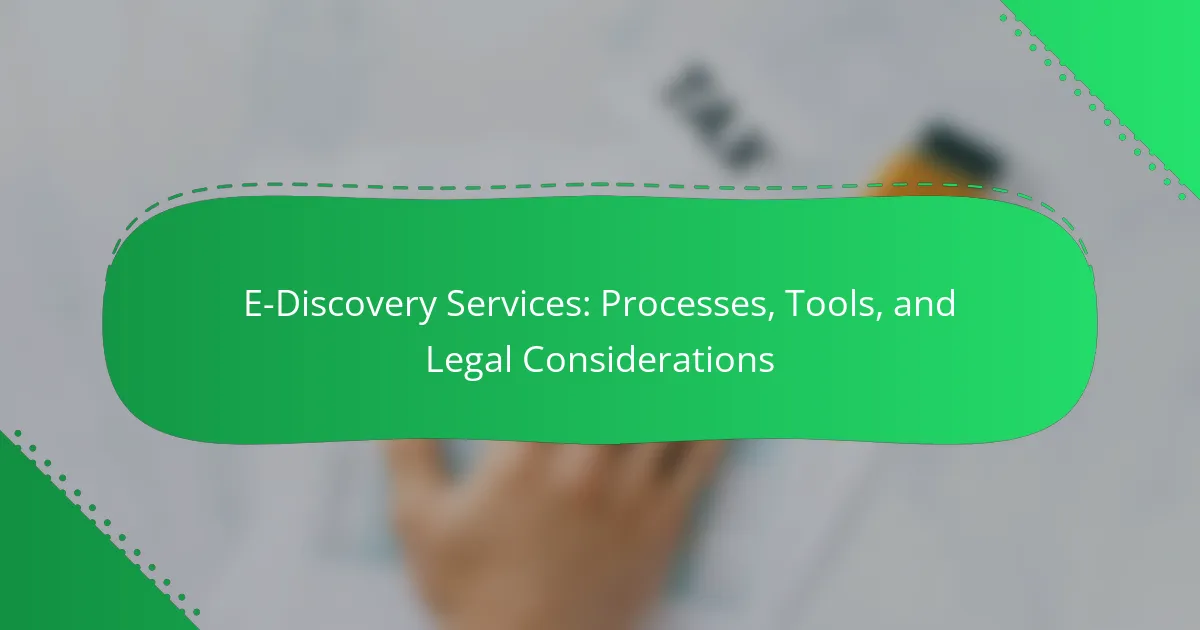Data preservation strategies are systematic approaches designed to maintain and protect data over time, ensuring its accessibility, usability, and security against risks such as corruption or loss. Key methods include data backup, data archiving, and data replication, each playing a vital role in safeguarding data integrity and availability. Legal implications necessitate compliance with regulations regarding data retention and privacy, highlighting the importance of documenting preservation processes. Best practices for implementing these strategies involve establishing clear policies, utilizing secure storage solutions, and training staff to enhance compliance and effectiveness. Organizations that adopt robust data preservation strategies tend to experience fewer data loss incidents, thereby improving overall data integrity.

What are Data Preservation Strategies?
Data preservation strategies are systematic approaches to maintaining and protecting data over time. These strategies ensure data remains accessible, usable, and secure, despite potential risks like corruption or loss. Common methods include regular backups, data redundancy, and the use of secure storage solutions. Legal implications often require compliance with regulations for data retention and privacy. Best practices involve assessing data value, implementing encryption, and documenting preservation processes. Research indicates that organizations employing robust data preservation strategies experience fewer data loss incidents, enhancing overall data integrity.
How do Data Preservation Strategies work?
Data preservation strategies work by systematically organizing and storing data to ensure its longevity and accessibility. These strategies involve identifying critical data, classifying it, and implementing storage solutions that mitigate risks such as data loss or corruption. Techniques include regular backups, use of redundancy, and adherence to legal compliance standards. For example, the National Archives and Records Administration recommends specific formats and storage conditions to preserve digital records. Additionally, organizations often employ data lifecycle management to determine when to retain or dispose of data. Research indicates that proper data preservation can reduce the risk of data loss by up to 70%.
What are the key components of Data Preservation Strategies?
Key components of data preservation strategies include data redundancy, format integrity, access control, and metadata management. Data redundancy ensures that copies of data exist in multiple locations. This minimizes the risk of data loss due to hardware failure or accidental deletion. Format integrity maintains the usability of data over time by using standard and widely supported file formats. Access control protects data from unauthorized access and ensures that only authorized users can modify or delete data. Metadata management involves the systematic organization of data descriptions, which aids in data retrieval and understanding. Each of these components plays a crucial role in ensuring data remains accessible and intact over time.
How do these components influence data integrity?
Components such as data validation, error detection, and access controls significantly influence data integrity. Data validation ensures that only accurate and relevant data is entered into a system. This process minimizes errors from the outset, maintaining the quality of the data. Error detection mechanisms, like checksums and hash functions, identify any discrepancies in data during storage or transmission. These tools help to ensure that data remains unchanged and reliable over time. Access controls restrict who can modify or delete data, reducing the risk of unauthorized changes. When access is limited to trusted users, the integrity of the data is better preserved. Collectively, these components create a robust framework that safeguards data integrity against corruption and unauthorized alterations.
Why are Data Preservation Strategies important?
Data preservation strategies are important because they ensure the integrity and availability of critical information. These strategies protect data from loss due to accidental deletion, system failures, or disasters. They also facilitate compliance with legal and regulatory requirements, such as data protection laws. For instance, organizations may face penalties for failing to retain records as mandated by the law. Additionally, effective data preservation supports research and historical documentation. It allows for the retrieval of valuable insights over time. According to a study by the National Archives, 70% of data loss incidents could be prevented with proper preservation strategies. Thus, implementing these strategies is essential for safeguarding organizational knowledge and maintaining operational continuity.
What risks are associated with inadequate data preservation?
Inadequate data preservation poses significant risks to organizations and individuals. These risks include data loss, which can result from hardware failures, software corruption, or accidental deletion. When data is lost, it may lead to operational disruptions and financial losses. Additionally, inadequate preservation can compromise data integrity, making it unreliable for decision-making. This can affect compliance with legal and regulatory requirements, resulting in legal penalties. Furthermore, sensitive information may be exposed due to insufficient security measures, increasing the risk of data breaches. Organizations can face reputational damage and loss of customer trust as a consequence. According to a study by the Ponemon Institute, the average cost of a data breach in 2021 was $4.24 million, highlighting the financial implications of inadequate data preservation.
How do Data Preservation Strategies protect against data loss?
Data preservation strategies protect against data loss by implementing systematic methods to safeguard information. These strategies include regular backups, which create copies of data at scheduled intervals. They also involve data redundancy, where multiple copies of data are stored in different locations. This ensures that if one copy is lost, others remain accessible. Additionally, data integrity checks monitor the accuracy and consistency of data over time. Encryption protects data from unauthorized access, which can lead to loss or corruption. Using version control allows recovery of previous data states, minimizing the impact of accidental deletions or changes. According to a study by the National Institute of Standards and Technology, organizations that implement comprehensive data preservation strategies significantly reduce their risk of data loss incidents.

What methods are used in Data Preservation Strategies?
Data preservation strategies utilize several key methods. These methods include data backup, data archiving, and data replication. Data backup involves creating copies of data to restore in case of loss. Regular backups are essential to minimize data loss risks. Data archiving is the process of moving inactive data to a separate storage for long-term retention. This helps in managing active data efficiently. Data replication involves copying data across multiple locations to ensure availability and reliability. These methods are critical in maintaining data integrity and accessibility over time.
What are the common methods for preserving data?
Common methods for preserving data include backup, archiving, and replication. Backup involves creating copies of data to restore in case of loss. Archiving stores data that is not actively used but must be retained for future reference. Replication creates duplicates of data across multiple locations to ensure availability. These methods help protect against data loss due to hardware failure, accidental deletion, or disasters. Regularly updating backups and verifying data integrity are essential practices in data preservation.
How does backup and recovery contribute to data preservation?
Backup and recovery are essential for data preservation. They ensure that data remains intact and accessible even after loss events. Regular backups create copies of data at specific intervals. This allows for restoration to a previous state if data is corrupted or lost. Recovery processes help retrieve lost data from these backups. According to a study by the Ponemon Institute, 70% of companies that experienced data loss reported that a robust backup solution was critical for recovery. This highlights the importance of backup and recovery in maintaining data integrity and availability.
What role do digital archives play in data preservation?
Digital archives are essential for data preservation. They store, organize, and provide access to digital information over time. Digital archives help prevent data loss due to hardware failure, natural disasters, or obsolescence. They utilize various formats and technologies to ensure long-term accessibility. Metadata in digital archives enhances discoverability and context for preserved data. The National Archives and Records Administration states that digital preservation strategies are crucial for maintaining the integrity of digital records. Regular updates and migrations of data formats ensure continued usability. Overall, digital archives play a critical role in safeguarding valuable information for future generations.
What technologies support Data Preservation Strategies?
Technologies that support data preservation strategies include cloud storage, data archiving solutions, and backup systems. Cloud storage provides scalable and secure options for long-term data retention. It allows organizations to store large volumes of data off-site, ensuring accessibility and protection against local disasters. Data archiving solutions help in organizing and retaining inactive data, making it easier to retrieve when needed. Backup systems ensure that copies of data are created regularly, safeguarding against loss due to hardware failure or cyber threats. These technologies are essential for maintaining data integrity and compliance with legal requirements.
How do cloud storage solutions enhance data preservation?
Cloud storage solutions enhance data preservation by providing secure, scalable, and accessible storage options. They protect data from hardware failures through redundancy and backups. Cloud providers typically utilize multiple data centers to ensure data availability. This geographical distribution reduces the risk of data loss due to local disasters. Additionally, cloud storage often includes automated versioning, allowing users to recover previous file versions. Encryption during transmission and at rest further secures data against unauthorized access. According to a study by the International Data Corporation, 70% of businesses that use cloud storage report improved data recovery capabilities. These features collectively contribute to more effective and reliable data preservation strategies.
What are the benefits of using encryption in data preservation?
Encryption enhances data preservation by ensuring confidentiality and integrity. It protects sensitive information from unauthorized access. This is crucial for compliance with data protection regulations, such as GDPR and HIPAA. Encryption also safeguards data during storage and transmission. According to a study by the Ponemon Institute, 70% of organizations experienced a data breach due to unencrypted data. Additionally, encryption helps maintain data integrity by preventing unauthorized alterations. Overall, encryption is a vital strategy for secure data preservation.

What are the legal implications of Data Preservation Strategies?
Data preservation strategies have significant legal implications. These strategies often involve retaining electronic data for compliance with regulations. For example, organizations must adhere to data retention laws such as the Sarbanes-Oxley Act. Failure to preserve relevant data can lead to legal penalties or sanctions. Courts may impose fines if data is not available during litigation. Additionally, improper data handling can result in breaches of privacy laws, such as GDPR. Organizations must implement clear policies for data preservation to mitigate risks. Documenting data management processes is essential for legal protection.
What regulations govern data preservation practices?
Data preservation practices are governed by various regulations. Key regulations include the General Data Protection Regulation (GDPR) in the European Union. The GDPR mandates that personal data must be retained only as long as necessary for its intended purpose. Another important regulation is the Health Insurance Portability and Accountability Act (HIPAA) in the United States. HIPAA requires healthcare organizations to retain patient records for a minimum of six years. Additionally, the Sarbanes-Oxley Act (SOX) imposes data retention requirements for financial records. Compliance with these regulations is essential for organizations to avoid legal penalties.
How do compliance requirements impact data preservation strategies?
Compliance requirements significantly influence data preservation strategies. Organizations must adhere to regulations such as GDPR and HIPAA. These laws dictate how long data must be retained and how it should be protected. Failure to comply can result in hefty fines and legal repercussions. For instance, GDPR mandates that personal data be stored no longer than necessary. This compels organizations to implement strict data retention policies. Additionally, compliance requires robust security measures to safeguard sensitive information. The need for audit trails and documentation further shapes preservation methods. Overall, compliance requirements necessitate a proactive approach to data management.
What are the consequences of failing to adhere to data preservation laws?
Failing to adhere to data preservation laws can result in significant legal consequences. Organizations may face hefty fines imposed by regulatory bodies. For instance, the General Data Protection Regulation (GDPR) can impose fines up to €20 million or 4% of annual global turnover. Legal actions may arise from affected parties seeking damages for data loss. Additionally, non-compliance can lead to loss of reputation, damaging stakeholder trust. Organizations may also experience operational disruptions due to investigations. These consequences underscore the importance of strict adherence to data preservation laws.
How can organizations ensure legal compliance in data preservation?
Organizations can ensure legal compliance in data preservation by implementing a robust data governance framework. This framework should include clear policies for data retention and destruction. Regular audits must be conducted to verify adherence to these policies. Training staff on data compliance requirements is essential. Organizations should also stay updated on relevant laws and regulations, such as GDPR or HIPAA. Utilizing technology solutions for data management can enhance compliance efforts. Documenting all data handling processes provides proof of compliance. This systematic approach helps mitigate legal risks associated with data preservation.
What best practices should be followed to maintain compliance?
To maintain compliance, organizations should implement a robust data governance framework. This framework must include clear policies and procedures for data management. Regular training on compliance requirements is essential for all employees. Regular audits and assessments help identify compliance gaps. Documentation of data processing activities is necessary to demonstrate accountability. Organizations should stay updated on relevant laws and regulations. Engaging legal counsel for compliance guidance is advisable. Utilizing technology solutions for data tracking can enhance compliance efforts.
How can organizations conduct audits for data preservation compliance?
Organizations can conduct audits for data preservation compliance by establishing a structured audit framework. This framework should include identifying relevant data retention policies. Organizations must assess their data management practices against these policies. They should gather documentation and records related to data handling and storage. Regularly scheduled audits can help ensure ongoing compliance. Additionally, organizations should engage third-party auditors for an objective review. Compliance with legal standards, such as GDPR or HIPAA, must be verified during audits. Organizations can also utilize automated tools to streamline the auditing process. These steps help maintain data integrity and compliance with preservation requirements.

What are the best practices for implementing Data Preservation Strategies?
The best practices for implementing Data Preservation Strategies include establishing clear policies and procedures. Organizations should define what data needs preservation based on its value and legal requirements. Regularly assess data preservation needs to adapt to changing regulations and technologies. Utilize secure storage solutions to protect data from unauthorized access and loss. Implement regular backups to ensure data recovery in case of corruption or disasters. Train staff on data preservation protocols to ensure compliance and effectiveness. Monitor and audit data preservation practices to identify and rectify any weaknesses. These practices help maintain data integrity and compliance with legal standards.
How can organizations develop effective data preservation policies?
Organizations can develop effective data preservation policies by identifying critical data assets. They should assess the types of data they hold and their importance. Establishing clear data retention schedules is essential. These schedules should outline how long different types of data will be kept. Organizations must comply with relevant legal and regulatory requirements. This ensures that data preservation aligns with laws governing data protection. Regularly reviewing and updating policies is necessary to adapt to changing technologies and regulations. Training employees on data preservation best practices enhances compliance and effectiveness. Implementing secure storage solutions protects data integrity and accessibility.
What factors should be considered when creating a data preservation plan?
Key factors to consider when creating a data preservation plan include data type, storage medium, and legal requirements. Understanding the data type helps determine appropriate preservation methods. The storage medium must ensure data integrity and accessibility over time. Legal requirements dictate compliance with regulations governing data retention and privacy. Additionally, risk assessment identifies potential threats to data security. Resource allocation ensures sufficient funding and personnel for preservation efforts. Lastly, establishing a review process allows for regular updates to the plan based on evolving technology and regulations.
How often should data preservation strategies be reviewed and updated?
Data preservation strategies should be reviewed and updated at least annually. Regular reviews ensure compliance with evolving regulations and technological advancements. Additionally, significant organizational changes or data management practices may necessitate more frequent updates. For instance, according to the National Archives and Records Administration, reviewing data management policies annually helps maintain effective preservation practices. This frequency allows organizations to adapt to new challenges and improve data integrity over time.
What tips can help improve data preservation efforts?
Implementing a robust data management plan is essential for improving data preservation efforts. Regularly backing up data to multiple locations reduces the risk of loss. Utilizing cloud storage solutions ensures accessibility and redundancy. Establishing clear data retention policies helps in managing data lifecycle effectively. Conducting periodic audits of data storage systems identifies potential vulnerabilities. Training staff on data handling and preservation best practices enhances overall compliance. Documenting data sources and preservation methods ensures transparency and accountability. Following industry standards and regulations reinforces data integrity and security.
How can staff training enhance data preservation practices?
Staff training enhances data preservation practices by equipping employees with essential knowledge and skills. Trained staff understand the importance of data integrity and security. They learn specific protocols for data handling and storage. This reduces the risk of data loss or corruption. Training also fosters a culture of accountability among employees. When staff are aware of the legal implications, they are more likely to comply with regulations. Research indicates that organizations with trained personnel experience fewer data breaches. For example, a study by the Ponemon Institute found that employee training can reduce the risk of data breaches by up to 45%.
What tools are available to assist in data preservation?
Data preservation tools include software and hardware designed to ensure data integrity and accessibility. Common tools are cloud storage services like Google Drive and Dropbox, which provide secure data backup. Data management software such as DSpace and Archivematica help organize and store digital assets. Additionally, physical storage solutions like external hard drives and network-attached storage (NAS) devices offer offline data preservation options. Encryption tools, including VeraCrypt, protect sensitive data from unauthorized access. Regular data validation tools ensure the accuracy and integrity of preserved data. These tools collectively support effective data preservation strategies across various contexts.
Data preservation strategies are systematic approaches designed to maintain and protect data over time, ensuring its accessibility, usability, and security. The article covers the methods used in data preservation, such as regular backups, data redundancy, and secure storage solutions, while highlighting key components that influence data integrity, including access control and metadata management. It also addresses the legal implications of data preservation, compliance requirements, and best practices for developing effective data preservation policies. Additionally, the article emphasizes the importance of staff training and the use of various tools to enhance data preservation efforts and mitigate risks associated with inadequate preservation.



